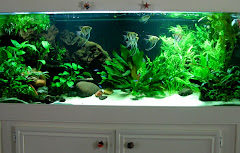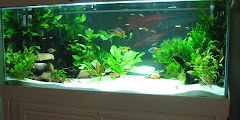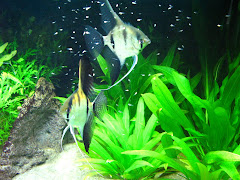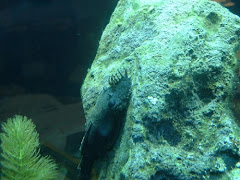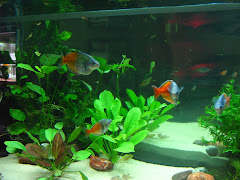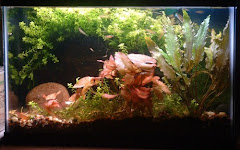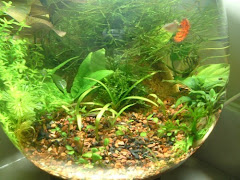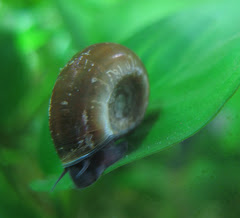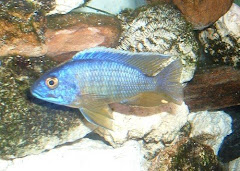Also known as "red head," these eartheaters (they are bottom dwelling cichlids that spend a lot of time sifting through the sand for morsels) are a species that don't get too large, up to about 6-7" for domestics, and have gorgeous red coloration. I plan on starting out with #20 1.5-2" fry next week and will grow them out in the 150-gallon, then sell off the extras later, when they start to get some size to them.
They do well in groups, so I hope to retain quite a few of them in this tank long-term. They are relatively peaceful, as cichlids go, and are not secretive, so they won't be hiding in the rocks. I had my eye on Satanoperca (they've their own genus now, out of the Geophagus genus for the time being) daemon, since I see them locally, but the more I read the more I find them to be particularly prone to bloat, and are much more sensitive to water quality. They also reach about 10", which is fine for my 150 if I limit them to about 5, but then I have to be very careful about sex ratios. I am not intimidated by fish that demand clean water, since my water change regimen makes my tanks clean and healthy (see below ember tetra and black neon spawns in my community 40-gallon!) but my recent mysterious disaster with my Tang cichlids has me a bit gun shy. I also prefer the red coloration of the Tapajos.
I will post pics when I get them. I'll likely move my wild P. leopoldi angel down into that tank with them, and try to locate more wild or wild-type (F1-2) angels for this setup - they will go well together.
For the purist making aquascaping recommendations for an eartheater tank, my setup has much too much rockwork - a shameful waste of space! When you look through Google images for eartheaters the tanks you see will most often be rather spare, with sand, a few flat rocks for spawning, a piece or two of driftwood, and that's it. This lends a great simplistic look to the tank, and is something I admire and tried to recreate with my Tanganyikan setup, but ultimately, in practice, I find the look too simplistic (maybe I'm doing it wrong) and my eye demands more vertical interest, with zones that draw the eye. Somehow this will need to work for the fish and for my stupid "eye," and I hope I can make that happen. Some of the Acaras are cavedwellers and I could stock some to inhabit the caves, but I might just stick with angels and geos (maybe some larger tetras?) and perhaps Peckoltia sp. catfish for the caves at some point, or even cories. That's for later - right now I'm going to concentrate on the geos, then angels, and see where things go from there.
Monday, November 21, 2011
Sunday, November 20, 2011
Another Tetra Spawn
I am happy to report that my 40-gal planted tank has new black neon fry! This is really amazing to me, on the heels of the ember tetra spawn. It is my experience that spawning tetras requires specific conditions and dedicated setups, but here they are.
I also have a couple of new additions to this tank, a pair of electric blue rams. They were given to me by a fellow hobbyist in Virginia Beach (thank you, Justin!) and have settled in very well in this heavily planted tank. There is a Bolivian ram (wild) in this tank as well, which looks absolutely beefy and monstrous next to the wee blue rams, as well as a wild leopoldi angel, with the ember tetras, black neons, het rasboras and a couple of cardinals. This setup is quite well established and is one of only two tanks I have that have remained as is for years, without getting bored with it and redoing it (or killing off all inhabitants....) so I think this goes a long way to making the environment hospitable for a tetra spawn. It's hit the "sweet spot," so to speak, and I'm just delighted. If the population of tetras can raise one or two of the fry to adulthood on any kind of regular basis I can maintain the colony for a good while.
I also have a couple of new additions to this tank, a pair of electric blue rams. They were given to me by a fellow hobbyist in Virginia Beach (thank you, Justin!) and have settled in very well in this heavily planted tank. There is a Bolivian ram (wild) in this tank as well, which looks absolutely beefy and monstrous next to the wee blue rams, as well as a wild leopoldi angel, with the ember tetras, black neons, het rasboras and a couple of cardinals. This setup is quite well established and is one of only two tanks I have that have remained as is for years, without getting bored with it and redoing it (or killing off all inhabitants....) so I think this goes a long way to making the environment hospitable for a tetra spawn. It's hit the "sweet spot," so to speak, and I'm just delighted. If the population of tetras can raise one or two of the fry to adulthood on any kind of regular basis I can maintain the colony for a good while.
New Incarnation
Here's the 150-gallon, redone for my SA eartheaters and others. The water is cloudy because I just finished rearranging rocks and the sand being stirred up creates billowing clouds of tiny particles.
I really had to manhandle the rocks quite a bit, not happy with the first 50 placements of them or the wood, but finally got something that I'm happy with. The wood could be pointing 10 degrees up or down and look "off" visually, so I messed with it until I achieved some sort of visual balance, at least to my eye. I removed quite a few rocks that were cluttering things up. I don't need much in the way of rocks at all for this setup (maybe some acaras, since they like to use caves? Peckoltia compta or another "leopard" pleco type would work as well).
I will be looking for a species of Satanoperca (depending upon availability) and some wild or wild-type angels. I think they will look great in there together, with the angels occupying the middle and upper strata and the eartheaters the bottom.
I scored a sweet piece of branchy driftwoodrecently from Fin & Feather. Sometimes they don't have much in the way of wood and decor, other than plastic and colored gravel, but that time they were loaded up with wood, so I got it relatively cheap, since it was not the curly heavy Mopani wood ($$$$!!!) but just plain old driftwood. It was soaked first and is being held down with a rock for good measure.
When you go back to the beginning of the blog it seems like this tank has been so many things, and I suppose it has. I will say that I don't sit around and lick my wounds, though, and I became absolutely inspired by the idea of this next setup. The empty tank is like an artist's canvas, and I work with it and work with it until I achieve visual appeal. The aquarium hobby is an expression of art for me - living organic art - and my last project had the hardscape just like I wanted it but I was waiting for the large, full-grown frontosa to set off the monolithic rock structure and slate background - moving slowly around an almost moonscape of dim cool light, sand and rocks. Never got to see that.
Many aquarists consider themselves to have "arrived" when they are successful breeders, especially of the more delicate and unusual species. They set up fish rooms with row after row of tanks, nursing a mated pair and coaxing them into a spawn. It is almost as though this is the be all, end all for the hobby, and if you're not heading for that then you are not really serious. I don't really desire that at this point in my life, but rather I want to incorporate graceful living fish into my day to day life, like art on the wall. If the tank does not have visual appeal and does not fit in the room with the other functional and nonfunctional decor, then I don't like it.
So, for now, this tank is set up, and I'm waiting on a cycle to introduce some interesting cichlids, and I will continue to attempt to keep them alive!
I really had to manhandle the rocks quite a bit, not happy with the first 50 placements of them or the wood, but finally got something that I'm happy with. The wood could be pointing 10 degrees up or down and look "off" visually, so I messed with it until I achieved some sort of visual balance, at least to my eye. I removed quite a few rocks that were cluttering things up. I don't need much in the way of rocks at all for this setup (maybe some acaras, since they like to use caves? Peckoltia compta or another "leopard" pleco type would work as well).
I will be looking for a species of Satanoperca (depending upon availability) and some wild or wild-type angels. I think they will look great in there together, with the angels occupying the middle and upper strata and the eartheaters the bottom.
I scored a sweet piece of branchy driftwoodrecently from Fin & Feather. Sometimes they don't have much in the way of wood and decor, other than plastic and colored gravel, but that time they were loaded up with wood, so I got it relatively cheap, since it was not the curly heavy Mopani wood ($$$$!!!) but just plain old driftwood. It was soaked first and is being held down with a rock for good measure.
When you go back to the beginning of the blog it seems like this tank has been so many things, and I suppose it has. I will say that I don't sit around and lick my wounds, though, and I became absolutely inspired by the idea of this next setup. The empty tank is like an artist's canvas, and I work with it and work with it until I achieve visual appeal. The aquarium hobby is an expression of art for me - living organic art - and my last project had the hardscape just like I wanted it but I was waiting for the large, full-grown frontosa to set off the monolithic rock structure and slate background - moving slowly around an almost moonscape of dim cool light, sand and rocks. Never got to see that.
Many aquarists consider themselves to have "arrived" when they are successful breeders, especially of the more delicate and unusual species. They set up fish rooms with row after row of tanks, nursing a mated pair and coaxing them into a spawn. It is almost as though this is the be all, end all for the hobby, and if you're not heading for that then you are not really serious. I don't really desire that at this point in my life, but rather I want to incorporate graceful living fish into my day to day life, like art on the wall. If the tank does not have visual appeal and does not fit in the room with the other functional and nonfunctional decor, then I don't like it.
So, for now, this tank is set up, and I'm waiting on a cycle to introduce some interesting cichlids, and I will continue to attempt to keep them alive!
DISASTER!
This is hard. Really hard! Difficult to tell, I mean. This is the story of how I lost all of my Tanganyikans from my 150 gallon tank. Well, not really how I lost them, because I can't say, but the story of the death of an entire stocked tank in a matter of hours.
Here's how it went:
I did my weekly PWC on Sunday afternoon, 4-ish, and I do only a 1/3 change because these are sensitive fish and any more than that seems to stress them. My other tanks get 1/2 PWC once a week. I did not disturb the decor or sand at all this time (it remains relatively clean without debris accumulating), but I simply placed the Python siphon hose into the water and started draining, then when it was 1/3 gone I tested my new tap water for temperature match and started refilling, taking care to add the correct amount of Prime. I have to be careful about temperature in particular because, again, they are sensitive and they show it when you are not careful about it. I have a pretty solid routine down, since this is a valuable tank in terms of the cost of the stock, as anyone who keeps or has kept Tanganyikan cichlids can attest. I've made mistakes with Tang cichlids in the past and treated this tank like the prima donnas they were.
Everything went fine, and we went out to dinner. No one was at home while we were out. We come home later and I fed them, and they all ate normally. We went to bed, and when I got up Monday morning everything looked fine, and we all left for work and school. We were all gone all day, with nobody home. When I got home from work my daughter alerted me that some of the fish were lying on the sand. Uh oh. What could this be?
I did a big PWC, thinking that something got into the tank, even though another PWC this soon after the first is risky, but I had to do something to try to save the tank, which was in obvious distress. All members were either dead or dying. Every last one. This included four 3.5-inch Kapampa frontosa, six Paracyprichromis nigripinnis, one 3-inch N. leleupi, and about 10-12 Altolamprologus species of various sizes, from 1.5" to 3". The water tested fine, in that there was no ammonia or nitrite, and very low nitrate (it hardly ever measures much nitrate, considering how small the fish were for this much water). This did not look like a case of not adding enough dechlor, since the times I have done that the water starts to cloud up and you see the params go wonky, and the fish start suffering immediately. I suppose this may not always be how it presents, but just in my own experience. Chlorine present in the water is not something this group of cichlids would take their time to react to, in other words. Cross that mistake off my list.
What then? I tested the pH and the tap water is the 7.6 it always is, with the tank measuring only a tiny bit higher at 7.9. Sometimes I reach 8 but as the tank matures the sand is buffering the water less and less, it seems. At first I thought the tap was measuring way low, at 6.2, but my pH meter needs to be calibrated and the liquid reagent kit proved it to be more alkaline, as always, at 7.6 (I'm sending the meter off to Milwaukee to be properly calibrated, as the adjustment screws are not solving the problem).
Over a matter of hours all fish dead. Monday night I tore the tank completely apart, removing and cleaning all the rocks (there must be 300 pounds of rock!) and cleaning out the sand, then taking apart the filters, a Fluval FX5 and a Rena Filstart XP4 and sterilizing them, loading with all new media. This took hours to complete, and was quite a physical strain, but I could not sit there and look at this giant glass testament to my failure.
What went wrong? What happened to slowly kill off every last fish? I've been over it and over it, and even my husband, who was present during the PWC procedure, can't come up with anything that does not match with my recollection. When I fed them I used the New Life Spectrum cichlid pellet, like always, and this time I did not use any frozen food, which could potentially go bad and perhaps sicken the fish. I think it must have had something to do with the water change, but with these fish any mistakes made in that procedure are typically evident quite rapidly, in my experience, and not 24 hours later.
I suppose I will never know, but I will continue to beat myself up over it, and not only because of the massive financial investment that went down the drain. I feel like I ought to have been able to get this tank mature and grow out the frontosa to their potential size, and this goal is not going to be achieved, at least not in the near future. I just don't have the funds to invest in replacing the fish and starting over. Maybe someday I will git it another shot, but not now. It would be easier to take if I knew what happened, so it could be mitigated in the future, but I just can't think of what happened.
Incidentally, when I did the water change on the 150 I also did one on the 20h goldfish tank in the kitchen, and they never had any problems whatsoever. Not a ragged fin, cloudy eye or red gill in the bunch. That tank, in fact, was cleaned aggressively (this tank was cleaned after I was done with the 150) and I moved decor around to siphon out the copious debris that collects with these filthy fish, and wound up with about an 80% change of the water. This is a typical change for that tank, and the goldfish seem to thrive with this weekly routine. They are fantails, and their fins are in perfect shape, with no signs of any water quality issues. I would not dream of that kind of maintenance on a Tang cichlid tank.
It could be there was something in the tap water that affects Tang cichlids and does not affect goldfish, which is definitely possible - goldfish are known to be much hardier - but I won't likely ever know. Copper leaching into the tap water would affect many species, but with the higher range pH that is less of an issue. If we had soft, acidic water then that would be high on my list.
In the past when I have called the water treatment plant to inquire about certain values (some systems contain levels of NO3 -nitrate- that cause aquarists some problems, for instance) I am usually met with defensiveness, as if I'm trying to blame the water treatment people for health issues, which I'm not. I just like to know what I'm dealing with when I put tap water into my tanks. This is a huge part of the process and I don't have any control over what comes out of the tap. If they said to me, "oh yes, Sunday we registered a higher than normal level of ________ in the system. That might explain it" I'd be grateful and go on with my life. Maybe they could even tell me to avoid doing PWCs on a certain day of the month, perhaps. I just want to be informed so I can manage my livestock the best I can.
So, now I'm setting my sights on a less pricey species from the other side of the world, in South America. I'm going to turn this tank into an "eartheater" tank, with Satanoperca daemon, which sounds awful but actually is the designation of a species of cichlid that is attractive and peaceful. It has been known as Geophagus jurupari, but there is a lot of work being done on the taxonomy of the genus so it covers quite a few species. I have added wood and plants to the tank, but only plants that attach themselves to the wood and rocks, and nothing planted in the sand, because it will be uprooted by these sand-sifting cichlids. I will consider angels and acaras as well for this tank, which are other peaceful cichlids that are appropriate tankmates.
Right now the tank is cycling with some shubunkin (if you have been reading this blog you'll know that I do cycle tanks with fish and I'm not ashamed of it!) and after things have settled in the goldfish will go into a friend's pond. I'm doing large PWCs during the process, and we're about halfway there. The fish are about 3" long and there are only three of them in this huge tank, so nobody needs to get uptight about animal cruelty. I did the same thing with the goldfish I currently have in the kitchen, which started out cycling the 150 themselves a couple of years ago before I added my Tangs, and they are doing great to this day.
I am really trying to move on but will be affected by this traumatic event for a good while. I do feel like a failure but I'd sure like to know what I did. No broken heaters, no electrical shock, nobody spraying chemicals, painting nearby, etc. There was nothing in the water that I have a test kit for to explain it, so I guess it will always be a mystery, and be, to date, my biggest DISASTER!
Here's how it went:
I did my weekly PWC on Sunday afternoon, 4-ish, and I do only a 1/3 change because these are sensitive fish and any more than that seems to stress them. My other tanks get 1/2 PWC once a week. I did not disturb the decor or sand at all this time (it remains relatively clean without debris accumulating), but I simply placed the Python siphon hose into the water and started draining, then when it was 1/3 gone I tested my new tap water for temperature match and started refilling, taking care to add the correct amount of Prime. I have to be careful about temperature in particular because, again, they are sensitive and they show it when you are not careful about it. I have a pretty solid routine down, since this is a valuable tank in terms of the cost of the stock, as anyone who keeps or has kept Tanganyikan cichlids can attest. I've made mistakes with Tang cichlids in the past and treated this tank like the prima donnas they were.
Everything went fine, and we went out to dinner. No one was at home while we were out. We come home later and I fed them, and they all ate normally. We went to bed, and when I got up Monday morning everything looked fine, and we all left for work and school. We were all gone all day, with nobody home. When I got home from work my daughter alerted me that some of the fish were lying on the sand. Uh oh. What could this be?
I did a big PWC, thinking that something got into the tank, even though another PWC this soon after the first is risky, but I had to do something to try to save the tank, which was in obvious distress. All members were either dead or dying. Every last one. This included four 3.5-inch Kapampa frontosa, six Paracyprichromis nigripinnis, one 3-inch N. leleupi, and about 10-12 Altolamprologus species of various sizes, from 1.5" to 3". The water tested fine, in that there was no ammonia or nitrite, and very low nitrate (it hardly ever measures much nitrate, considering how small the fish were for this much water). This did not look like a case of not adding enough dechlor, since the times I have done that the water starts to cloud up and you see the params go wonky, and the fish start suffering immediately. I suppose this may not always be how it presents, but just in my own experience. Chlorine present in the water is not something this group of cichlids would take their time to react to, in other words. Cross that mistake off my list.
What then? I tested the pH and the tap water is the 7.6 it always is, with the tank measuring only a tiny bit higher at 7.9. Sometimes I reach 8 but as the tank matures the sand is buffering the water less and less, it seems. At first I thought the tap was measuring way low, at 6.2, but my pH meter needs to be calibrated and the liquid reagent kit proved it to be more alkaline, as always, at 7.6 (I'm sending the meter off to Milwaukee to be properly calibrated, as the adjustment screws are not solving the problem).
Over a matter of hours all fish dead. Monday night I tore the tank completely apart, removing and cleaning all the rocks (there must be 300 pounds of rock!) and cleaning out the sand, then taking apart the filters, a Fluval FX5 and a Rena Filstart XP4 and sterilizing them, loading with all new media. This took hours to complete, and was quite a physical strain, but I could not sit there and look at this giant glass testament to my failure.
What went wrong? What happened to slowly kill off every last fish? I've been over it and over it, and even my husband, who was present during the PWC procedure, can't come up with anything that does not match with my recollection. When I fed them I used the New Life Spectrum cichlid pellet, like always, and this time I did not use any frozen food, which could potentially go bad and perhaps sicken the fish. I think it must have had something to do with the water change, but with these fish any mistakes made in that procedure are typically evident quite rapidly, in my experience, and not 24 hours later.
I suppose I will never know, but I will continue to beat myself up over it, and not only because of the massive financial investment that went down the drain. I feel like I ought to have been able to get this tank mature and grow out the frontosa to their potential size, and this goal is not going to be achieved, at least not in the near future. I just don't have the funds to invest in replacing the fish and starting over. Maybe someday I will git it another shot, but not now. It would be easier to take if I knew what happened, so it could be mitigated in the future, but I just can't think of what happened.
Incidentally, when I did the water change on the 150 I also did one on the 20h goldfish tank in the kitchen, and they never had any problems whatsoever. Not a ragged fin, cloudy eye or red gill in the bunch. That tank, in fact, was cleaned aggressively (this tank was cleaned after I was done with the 150) and I moved decor around to siphon out the copious debris that collects with these filthy fish, and wound up with about an 80% change of the water. This is a typical change for that tank, and the goldfish seem to thrive with this weekly routine. They are fantails, and their fins are in perfect shape, with no signs of any water quality issues. I would not dream of that kind of maintenance on a Tang cichlid tank.
It could be there was something in the tap water that affects Tang cichlids and does not affect goldfish, which is definitely possible - goldfish are known to be much hardier - but I won't likely ever know. Copper leaching into the tap water would affect many species, but with the higher range pH that is less of an issue. If we had soft, acidic water then that would be high on my list.
In the past when I have called the water treatment plant to inquire about certain values (some systems contain levels of NO3 -nitrate- that cause aquarists some problems, for instance) I am usually met with defensiveness, as if I'm trying to blame the water treatment people for health issues, which I'm not. I just like to know what I'm dealing with when I put tap water into my tanks. This is a huge part of the process and I don't have any control over what comes out of the tap. If they said to me, "oh yes, Sunday we registered a higher than normal level of ________ in the system. That might explain it" I'd be grateful and go on with my life. Maybe they could even tell me to avoid doing PWCs on a certain day of the month, perhaps. I just want to be informed so I can manage my livestock the best I can.
So, now I'm setting my sights on a less pricey species from the other side of the world, in South America. I'm going to turn this tank into an "eartheater" tank, with Satanoperca daemon, which sounds awful but actually is the designation of a species of cichlid that is attractive and peaceful. It has been known as Geophagus jurupari, but there is a lot of work being done on the taxonomy of the genus so it covers quite a few species. I have added wood and plants to the tank, but only plants that attach themselves to the wood and rocks, and nothing planted in the sand, because it will be uprooted by these sand-sifting cichlids. I will consider angels and acaras as well for this tank, which are other peaceful cichlids that are appropriate tankmates.
Right now the tank is cycling with some shubunkin (if you have been reading this blog you'll know that I do cycle tanks with fish and I'm not ashamed of it!) and after things have settled in the goldfish will go into a friend's pond. I'm doing large PWCs during the process, and we're about halfway there. The fish are about 3" long and there are only three of them in this huge tank, so nobody needs to get uptight about animal cruelty. I did the same thing with the goldfish I currently have in the kitchen, which started out cycling the 150 themselves a couple of years ago before I added my Tangs, and they are doing great to this day.
I am really trying to move on but will be affected by this traumatic event for a good while. I do feel like a failure but I'd sure like to know what I did. No broken heaters, no electrical shock, nobody spraying chemicals, painting nearby, etc. There was nothing in the water that I have a test kit for to explain it, so I guess it will always be a mystery, and be, to date, my biggest DISASTER!
Subscribe to:
Posts (Atom)


